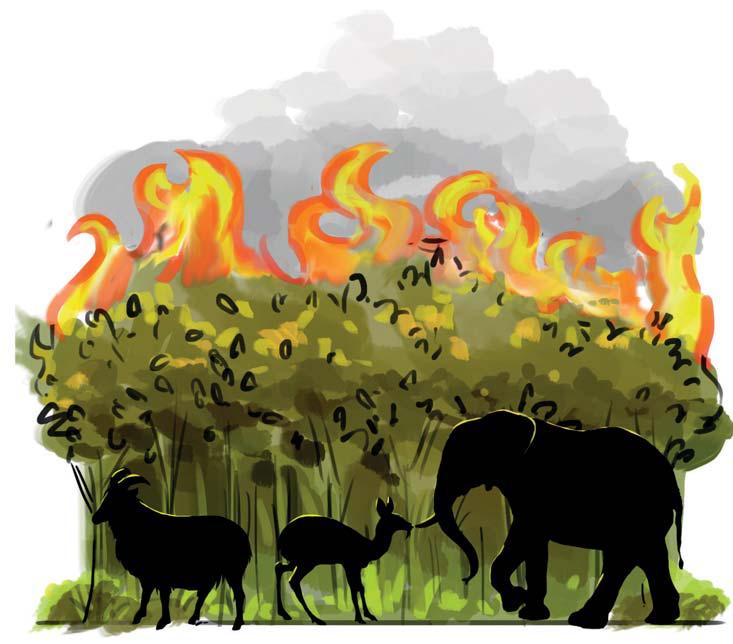
FOREST FIRES are becoming more frequent and fierce in Uttarakhand. Such regular burnings can be catastrophic for the state as well as the rich biodiversity it harbours. Uttarakhand is home to at least 102 species of mammals, 70 reptiles, 19 amphibians, and 124 species of fish. The state also boasts of 600 species of birds. The International Union for Conservation of Nature (IUCN) classifies 55 of the bird species as "threatened", of which six are critically endangered and four are endangered. Several mammalian fauna found in the state are also classified as endangered. The list includes the Asian elephant, tiger, Alpine musk deer, Himalayan musk deer, leopard, snow leopard, blue sheep, Himalayan Thar, leopard cat, Himalayan black bear, sloth bear and pangolin. With 7,000 species of plants, Uttarakhand contributes 31 per cent of the country's floral diversity. As many as 119 flowering plants are endemic to the state. The impact of recurrent forest fires in Uttarakhand is therefore not limited to the direct loss of trees and wildlife, their displacement and subsequent colonisation of unwanted species.
Forest fires can meddle with the life cycle of species and push many of the threatened and endemic species closer to extinction.
For instance, by destroying the leaves and foliage, a forest fire can significantly reduce the photosynthetic activity of surviving trees and thereby affect their growth. It can also damage the seed bank, both above and below the ground, and wipe out the seedlings and saplings growing on the forest floor. Species that are sparsely distributed and have small or patchy populations suffer the worst impacts as they lose their habitat, territories, shelter and food. The loss of keystone organisms in forest ecosystems, such as invertebrates, pollinators, and decomposers, can significantly slow the recovery rate of the forest.
This story is from the April 16, 2023 edition of Down To Earth.
Start your 7-day Magzter GOLD free trial to access thousands of curated premium stories, and 8,500+ magazines and newspapers.
Already a subscriber ? Sign In
This story is from the April 16, 2023 edition of Down To Earth.
Start your 7-day Magzter GOLD free trial to access thousands of curated premium stories, and 8,500+ magazines and newspapers.
Already a subscriber? Sign In

The Pill That's Roiling US Drug Regulation
The hard right is challenging FDA's authority to regulate drugs with its lawsuit to ban America's most used abortion pill

TURN OVER A NEW LEAF
The young leaves of pilkhan free are a worthy alternative to leafy vegetables in the spring season

FAIR PRICE
Using a calculator, Uttar Pradesh scientifically fixes fee for transporting faecal sludge to treatment plants

THE FOREVER POLLUTANT
From production to usage to disposal, plastic is a threat to those who come in its contact SIDDHARTH GHANSHYAM SINGH

Seeds from the past
For a decade,200 villages in Odisha have conserved and grown 190 indigenous rice and millet varieties with proven climate resilience

TESTING TIMES
While the world is trying to identify uniform tests to measure soil biodiversity, it still needs investment and infrastructure to make them available to all

BREAKING NEW GROUND
Soil health is typically measured by its nutrient content, by presence of elements like nitrogen and phosphorus. No country in the world measures it in terms of soil biodiversity-a counting of underground faunal populations and microorganisms.

PRIME TRIGGER
Heat stress dominates debate on the causes of a mysterious chronic kidney disease that continues to baffle health experts and is on the rise globally

Coral catastrophe
Consistent ocean heating puts global corals at risk of mass bleaching in 2024

CHIPKO A DISTANT MEMORY
Whenever a dictionary of green terms is written, no matter in what language, it will contain at least one Hindi word-Chipko, which means to hug.